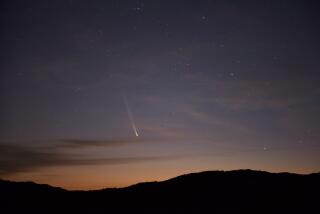Shifty Comet Makes Task of Intercept More Difficult
- Share via
A comet scheduled to be intercepted by a U.S. spacecraft Wednesday morning seems to have a mind of its own, “burping,” or flying erratically through the sky, as it approaches the celestial encounter.
Scientists working on the historic intercept say the comet, known as Giacobini-Zinner, keeps changing its course and is about 1,200 miles off the route originally projected by scientists at the National Aeronautics and Space Administration.
The fickle comet has forced scientists to fire the rockets on the spacecraft repeatedly to compensate for the course changes, said Robert Farquhar of NASA’s Goddard Space Flight Center in Greenbelt, Md.
The peculiar behavior of the comet is not expected to have a serious effect on Wednesday’s encounter, however.
“It seems to be settling down now,” said Farquhar, flight director for the spacecraft, known formally as the International Cometary Explorer.
Donald K. Yeomans of the Jet Propulsion Laboratory near Pasadena, who has been tracking the comet for Farquhar, said Giacobini-Zinner looks as if it is “burping” as it dodges through the sky.
Nobody has ever seen the nucleus of a comet because it is shrouded by gases and dust, but the center is believed to be a “snowball” of dirt and frozen gases. As the comet gets closer to the sun, some of the gas flares off, sometimes altering the course of the comet, Yeomans said.
“It’s like the comet has little rockets caused by the outgassing,” he said.
“This comet is sort of showing some youthful exuberance,” Yeomans said. “Just when you think you know exactly where it’s going to be, it thumbs its nose at you and says, ‘Nope, try again.’ ”
The outgassing indicates that Giacobini-Zinner’s trips toward the sun are a relatively new development, making the comet much younger than Halley’s Comet, which has been in a near-sun orbit for hundreds of years. Millions of comets never approach the sun but remain in a “comet cloud” in the outer reaches of the solar system.
Yeomans said the tracking problems are made more difficult by the fact that the nucleus cannot be seen.
“You have to infer where the nucleus is,” he said. “We never see the thing we are tracking.
“For Halley, there’s no problem,” he said. “Halley is an older, larger comet. This one is smaller, so it can be pushed around easier.”
Neither Farquhar nor Yeomans believes that the mission to Giacobini-Zinner is in danger because of the comet’s “exuberance.”
“I’m not worried about that,” Farquhar said.
He is, however, concerned that the spacecraft may be destroyed as it passes through the dusty tail of the comet.
The craft was launched in 1978 on a mission to study the sun and came to rest in an area where the gravitational pull from Earth and the sun is equal.
Nearly two years ago its rockets were used to kick it out of orbit and on to a new mission to study the comet.
Scientists at Goddard and JPL sent the craft on five “lunar swingbys,” using the gravitational pull of the moon to act as a slingshot on the passing craft, building up enough speed to whip it out to the intercept.
About 4 a.m. PDT Wednesday, the craft is to fly through the tail of Giacobini-Zinner to collect scientific data on the composition of the tail and such things as the comet’s magnetic field. That information will be radioed back to scientists at Goddard for analysis.
The spacecraft will get to Giacobini-Zinner six months before the first probes reach Halley’s Comet. None of the missions to Halley is U.S.-sponsored. They belong instead to the Soviet Union, Japan and Western Europe.
NASA decided against sending a probe to Halley because of the cost, much to the frustration of many American scientists.
The mission to Giacobini-Zinner grew out of that frustration. It is a make-do operation using an old but reliable spacecraft.






